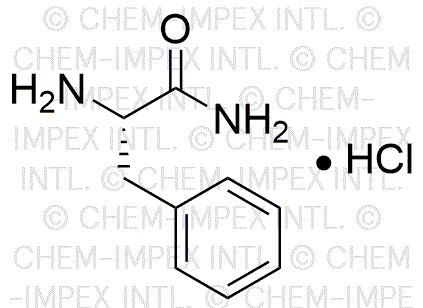L-Phenylalanine amide hydrochloride is widely utilized in research focused on:
- Neurotransmitter Support: This compound is a precursor to neurotransmitters like dopamine, making it valuable in studies related to mood regulation and cognitive function.
- Dietary Supplements: It is often included in nutritional products aimed at enhancing mental performance and reducing stress, appealing to health-conscious consumers.
- Pharmaceutical Development: Researchers explore its potential in developing treatments for conditions like depression and attention deficit disorders, providing innovative solutions in mental health.
- Protein Synthesis: In biochemistry, it serves as a building block for proteins, which is crucial for studies in cellular biology and metabolic processes.
- Flavoring Agent: The compound is also explored in the food industry for its potential to enhance flavors, offering an alternative to traditional flavor enhancers.
General Information
Properties
Safety and Regulations
Applications
L-Phenylalanine amide hydrochloride is widely utilized in research focused on:
- Neurotransmitter Support: This compound is a precursor to neurotransmitters like dopamine, making it valuable in studies related to mood regulation and cognitive function.
- Dietary Supplements: It is often included in nutritional products aimed at enhancing mental performance and reducing stress, appealing to health-conscious consumers.
- Pharmaceutical Development: Researchers explore its potential in developing treatments for conditions like depression and attention deficit disorders, providing innovative solutions in mental health.
- Protein Synthesis: In biochemistry, it serves as a building block for proteins, which is crucial for studies in cellular biology and metabolic processes.
- Flavoring Agent: The compound is also explored in the food industry for its potential to enhance flavors, offering an alternative to traditional flavor enhancers.
Documents
Safety Data Sheets (SDS)
The SDS provides comprehensive safety information on handling, storage, and disposal of the product.
Product Specification (PS)
The PS provides a comprehensive breakdown of the product’s properties, including chemical composition, physical state, purity, and storage requirements. It also details acceptable quality ranges and the product's intended applications.
Certificates of Analysis (COA)
Search for Certificates of Analysis (COA) by entering the products Lot Number. Lot and Batch Numbers can be found on a product’s label following the words ‘Lot’ or ‘Batch’.
*Catalog Number
*Lot Number
Certificates Of Origin (COO)
This COO confirms the country where the product was manufactured, and also details the materials and components used in it and whether it is derived from natural, synthetic, or other specific sources. This certificate may be required for customs, trade, and regulatory compliance.
*Catalog Number
*Lot Number
Safety Data Sheets (SDS)
The SDS provides comprehensive safety information on handling, storage, and disposal of the product.
DownloadProduct Specification (PS)
The PS provides a comprehensive breakdown of the product’s properties, including chemical composition, physical state, purity, and storage requirements. It also details acceptable quality ranges and the product's intended applications.
DownloadCertificates of Analysis (COA)
Search for Certificates of Analysis (COA) by entering the products Lot Number. Lot and Batch Numbers can be found on a product’s label following the words ‘Lot’ or ‘Batch’.
*Catalog Number
*Lot Number
Certificates Of Origin (COO)
This COO confirms the country where the product was manufactured, and also details the materials and components used in it and whether it is derived from natural, synthetic, or other specific sources. This certificate may be required for customs, trade, and regulatory compliance.


